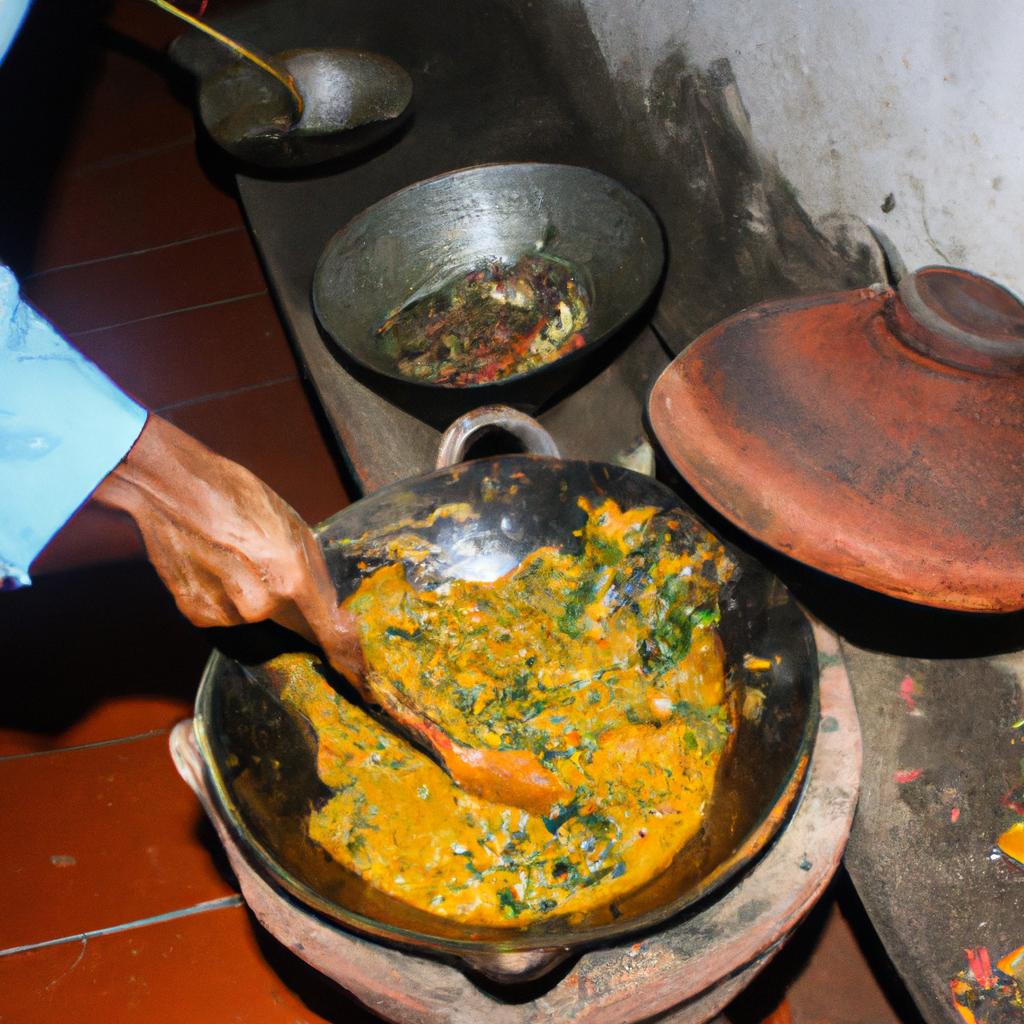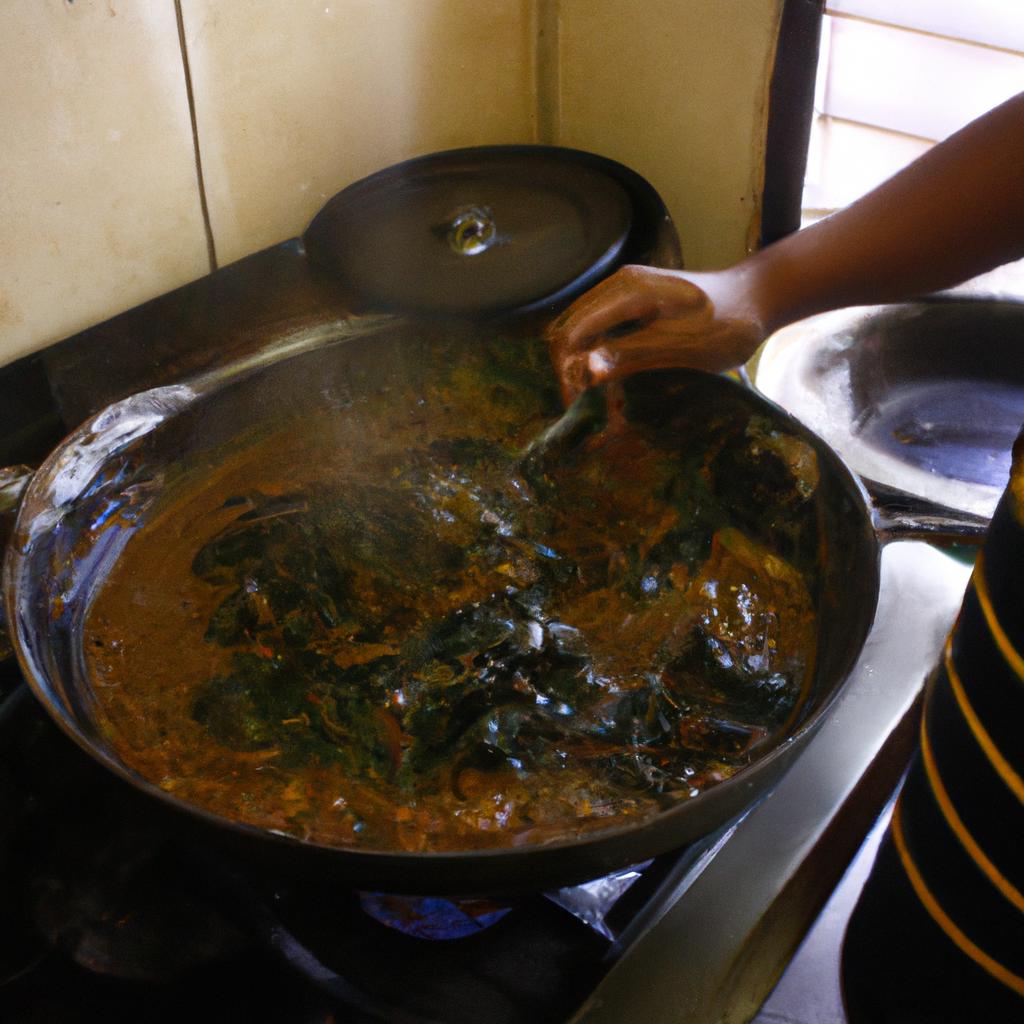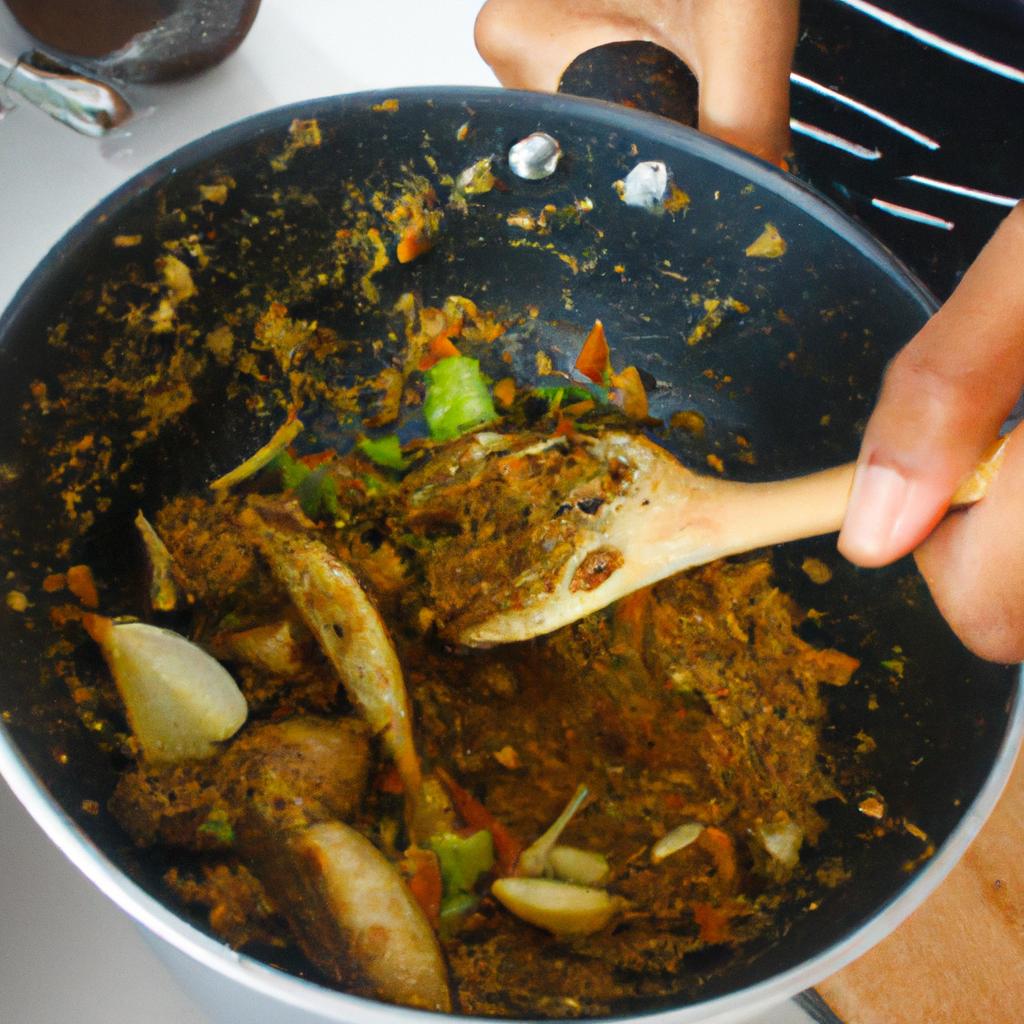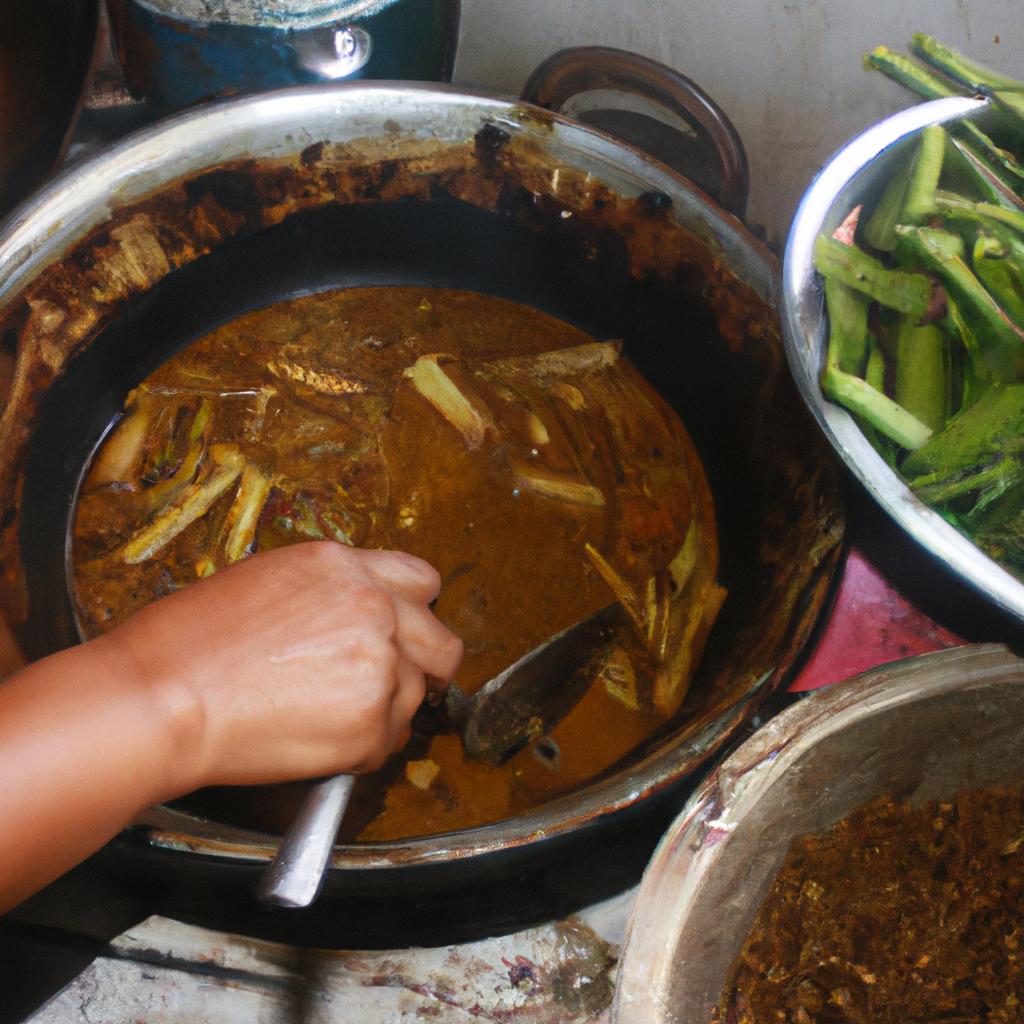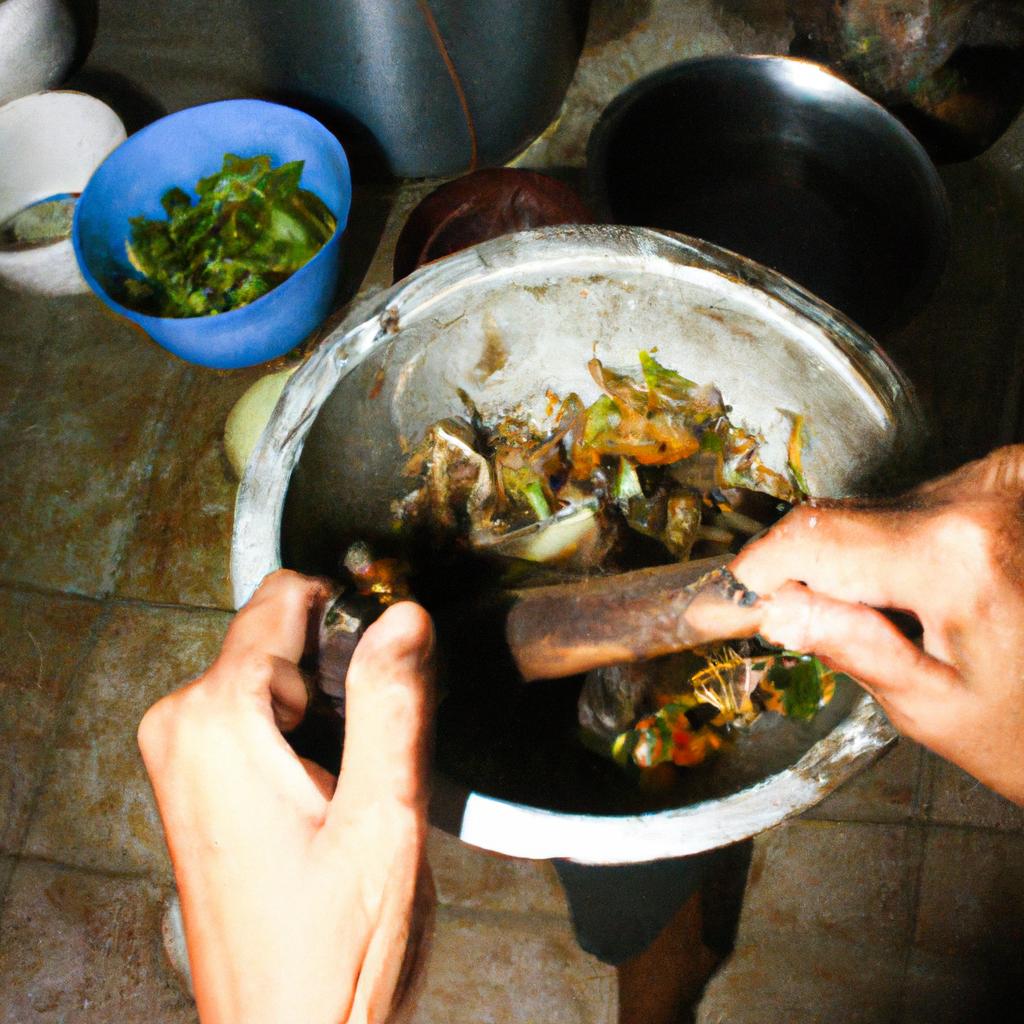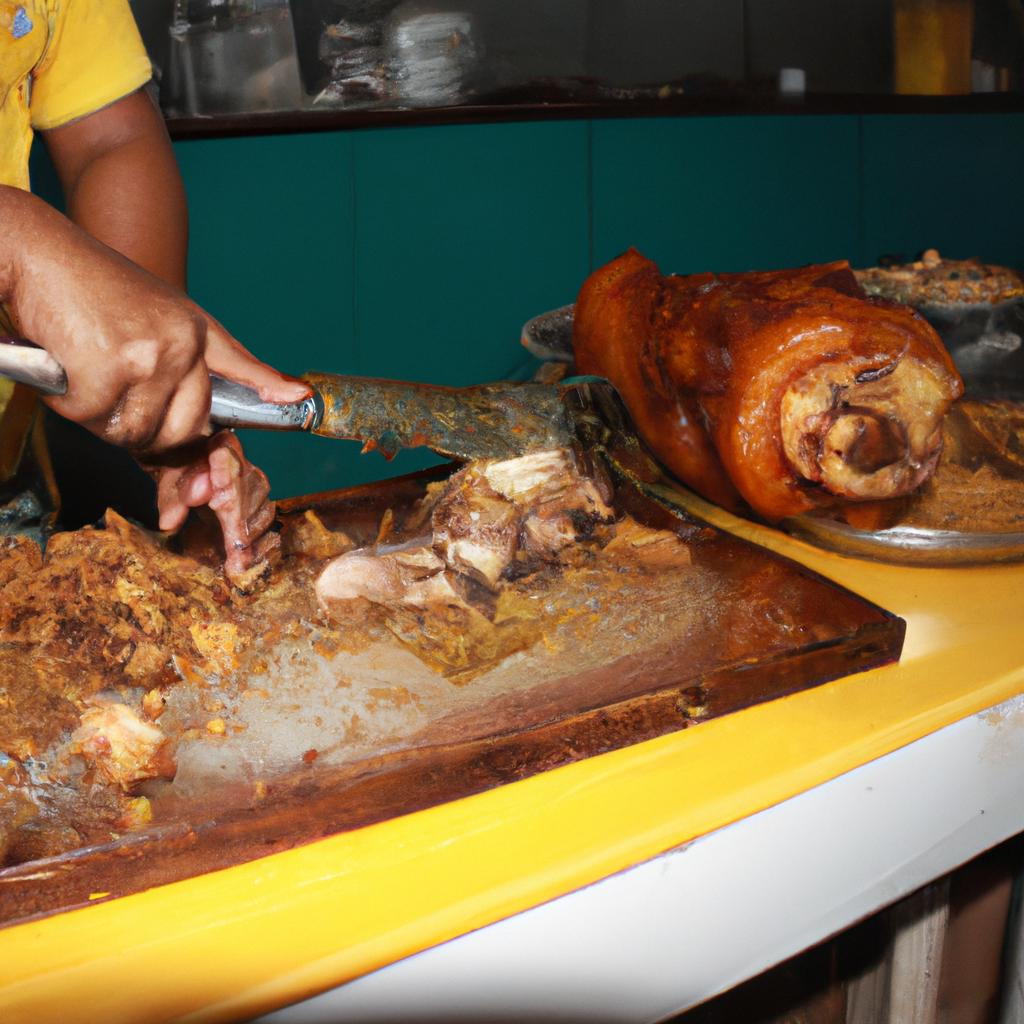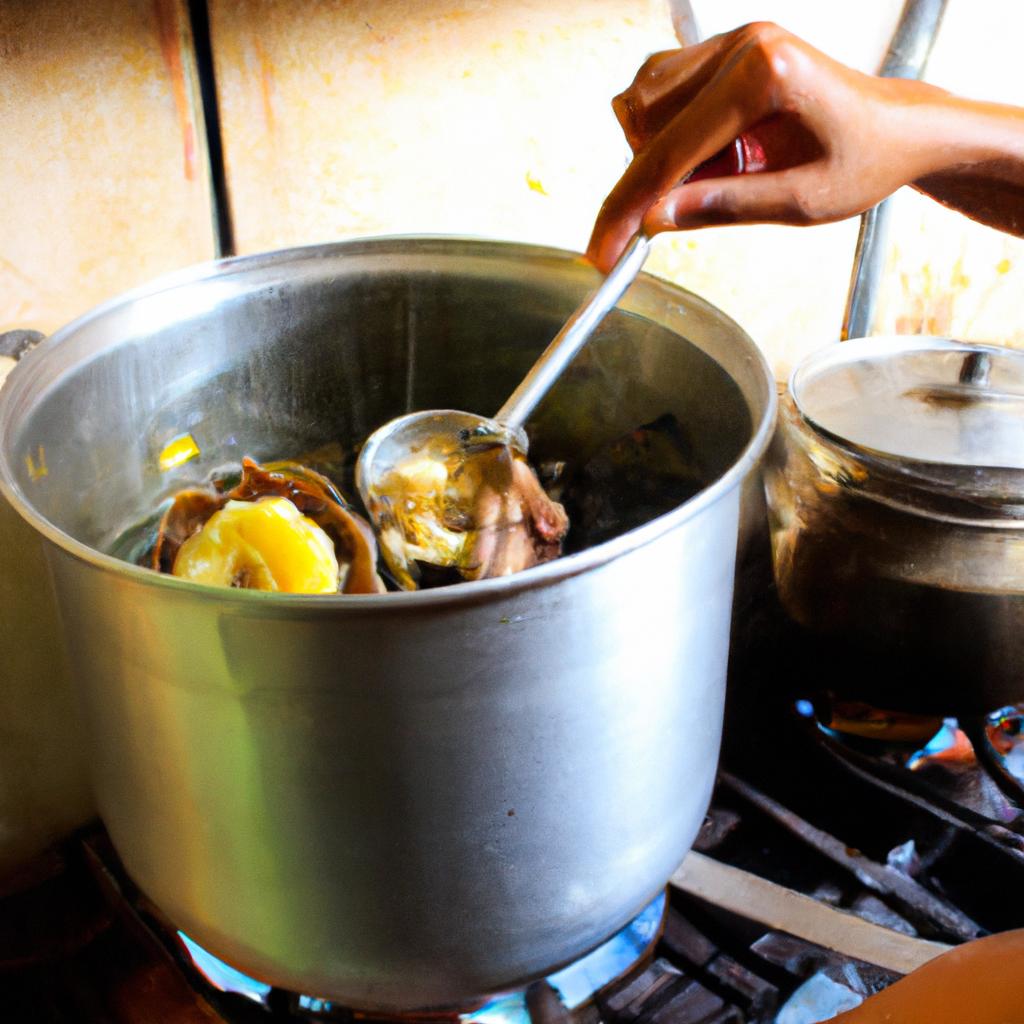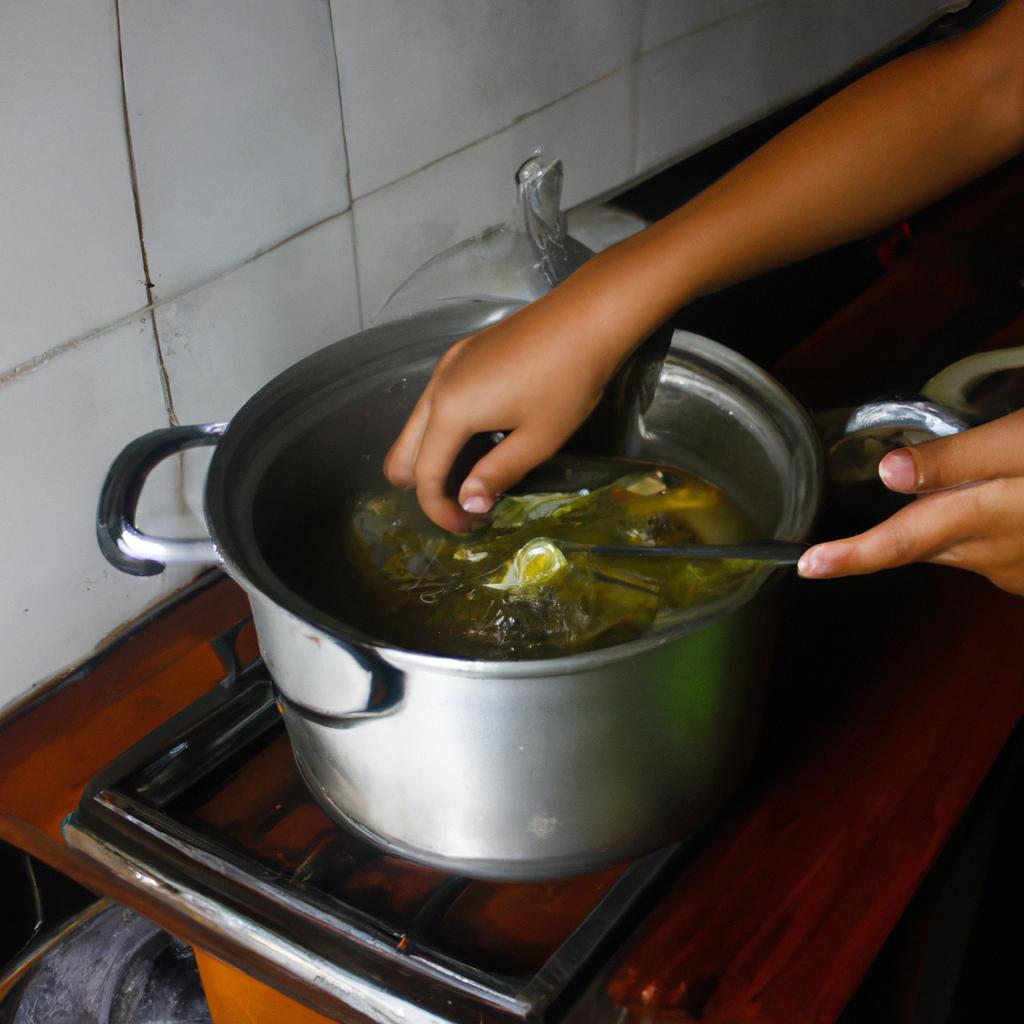Kare-Kare, a traditional Filipino delicacy, holds a significant place in the hearts and palates of Filipinos. This rich and flavorful dish is renowned for its unique combination of tender beef or oxtail simmered in a thick peanut sauce, accompanied by an assortment of vegetables such as eggplant and string beans. The interplay between the savory meat and the creamy nutty sauce creates a harmonious blend that leaves one craving for more.
To illustrate the widespread popularity of Kare-Kare, let us consider the case of Maria Santos, a Filipino immigrant residing in California. Despite being thousands of miles away from her homeland, Maria’s fondness for this beloved dish remains unwavering. She often reminisces about her childhood days when she would eagerly anticipate family gatherings where Kare-Kare was served with warm steamed rice. In order to satisfy her cravings and preserve her cultural heritage, Maria has taken it upon herself to master the art of preparing authentic Kare-Kare recipes in her American kitchen.
The origins of Kare-Kare can be traced back to pre-colonial times when indigenous tribes utilized peanuts as a primary ingredient in their cooking. Over time, Spanish influences introduced additional elements such as bagoong (a fermented shrimp paste) and ann atto seed powder to enhance the flavors of Kare-Kare. Today, variations of this dish can be found throughout the Philippines, with each region adding its own unique twist.
Preparing a traditional Kare-Kare involves several steps and careful attention to detail. The meat, whether it be beef or oxtail, is first boiled until tender. Meanwhile, the peanut sauce is prepared by grinding roasted peanuts into a smooth paste and combining it with annatto seed powder for color and flavor. Other ingredients such as garlic, onions, and shrimp paste are sautéed to add depth to the sauce.
Once the meat and sauce are ready, they are combined and simmered together along with various vegetables like eggplant, string beans, banana heart, and bok choy until everything is cooked to perfection. The result is a thick and luscious stew that tantalizes the taste buds with its rich aroma and complex flavors.
Kare-Kare is often enjoyed with steamed rice or sometimes paired with bagoong on the side for an extra kick of umami. It is commonly served during special occasions or family gatherings as it embodies the spirit of Filipino hospitality and tradition.
As Maria Santos continues her culinary journey in California, she not only satisfies her own cravings but also introduces her friends and neighbors to this authentic Filipino delicacy. Through her dedication to preserving her cultural heritage through food, Maria helps bridge the gap between two worlds while celebrating the beauty of diversity.
So next time you find yourself craving something truly unique and delicious, consider trying Kare-Kare – a dish that encapsulates the rich history and vibrant flavors of the Philippines.
Different ways to prepare Kare-Kare
Imagine a Filipino family gathered around the dining table, eagerly awaiting the arrival of their favorite dish – Kare-Kare. This rich and flavorful delicacy is a staple in Filipino cuisine, known for its distinctive peanut-based sauce and tender meat. While traditionally made with oxtail and tripe, Kare-Kare can be prepared using various ingredients, allowing for different interpretations of this beloved dish.
Preparation Variations:
- Vegetarian Twist: In response to the growing demand for plant-based options, vegetarian versions of Kare-Kare have gained popularity. Instead of using meat, vegetables like eggplant, string beans, and bok choy take center stage alongside tofu or seitan as protein substitutes. These additions lend vibrant colors and textures to the dish while still maintaining its signature taste.
- Seafood Delight: For those who prefer seafood over meat, incorporating shrimp or squid into Kare-Kare offers a delightful twist. The briny flavors from these ocean dwellers combine harmoniously with the nutty undertones of the sauce, creating an entirely new culinary experience that caters to diverse palates.
- Chicken Variation: Another variation that has emerged is chicken Kare-Kare. By replacing oxtail with succulent pieces of chicken, this adaptation offers a lighter alternative without compromising on flavor. The tenderness of the poultry complements the richness of the sauce perfectly, making it an ideal choice for individuals seeking a slightly healthier option.
- Fusion Flavors: As globalization continues to influence food cultures worldwide, creative chefs have infused international elements into traditional recipes like Kare-Kare. Some variations incorporate Thai curry paste or Indonesian spices into the peanut sauce to add layers of complexity and introduce exciting new dimensions to this classic Filipino delight.
Table showcasing various preparation variations:
| Preparations | Key Ingredients | Notable Characteristics |
|---|---|---|
| Vegetarian Twist | Eggplant, string beans, tofu or seitan | Vibrant colors and textures |
| Seafood Delight | Shrimp or squid | Briny flavors blending with nuttiness |
| Chicken Variation | Chicken instead of oxtail | Lighter yet still flavorful option |
| Fusion Flavors | Thai curry paste or Indonesian spices added | Exciting international fusion |
By exploring the diverse ways Kare-Kare can be prepared, one discovers that this Filipino delicacy is not limited by tradition alone. Now we delve into popular twists on the classic Kare-Kare recipe, where innovative ingredients and techniques take center stage in satisfying our culinary curiosity.
Popular twists on the classic Kare-Kare recipe
From the rich heritage of Filipino cuisine emerges Kare-Kare, a delightful and flavorful delicacy that has earned its place as a staple in Filipino households. In the previous section, we explored different ways to prepare this traditional dish, but now let us delve deeper into some popular twists on the classic Kare-Kare recipe.
To illustrate how creative variations can enhance the taste of Kare-Kare, consider an example where instead of using the typical peanut sauce base, one substitutes it with cashew nut butter. This subtle alteration brings a unique richness and creaminess to the dish while maintaining its distinct flavor profile. By experimenting with alternative ingredients like cashews or almonds, cooks are able to add their own personal touch to Kare-Kare without compromising its essence.
Exploring regional variations of Kare-Kare reveals an array of tantalizing possibilities for those seeking a fresh take on this beloved dish. Here are some notable examples:
- Bicol Express Twist: Infusing elements from Bicolano cuisine, this variation incorporates spicy chili peppers such as siling labuyo alongside coconut milk, creating a harmonious blend of heat and creaminess.
- Seafood Medley: A coastal twist on Kare-Kare replaces meat with seafood options like prawns, squid, or fish fillets. The briny flavors complemented by a tangy calamansi-based dipping sauce offer a refreshing departure from conventional renditions.
- Vegetarian Delight: For those embracing a plant-based lifestyle or simply looking for lighter fare, vegetables such as eggplant, okra, and bok choy take center stage in this rendition. The earthy notes combined with aromatic spices provide both nourishment and satisfaction.
- Fusion Innovation: Modern interpretations have seen chefs experiment with fusion cuisines incorporating international flavors. Imagine Korean gochujang-infused Kare-Kare highlighting bold spice undertones paired with tender beef short ribs; truly an enticing cross-cultural marriage.
By exploring these innovative twists on the classic Kare-Kare recipe, one can appreciate the versatility and adaptability of this Filipino delicacy. The regional variations showcase how different culinary influences come together to create a diverse tapestry of flavors that captivate both local palates and international food enthusiasts alike.
In the upcoming section, we will continue our culinary journey by delving into the fascinating realm of exploring regional variations of Kare-Kare without missing a beat.
Exploring regional variations of Kare-Kare
After discussing popular twists on the classic Kare-Kare recipe, let us now delve into the fascinating world of regional variations. One notable example is the Ilocano version called “Kabatitiang Bagnet Kare-Kare.” This unique twist combines the rich flavors of traditional bagnet (deep-fried pork belly) with the creamy and savory Kare-Kare sauce. The resulting dish offers a delightful contrast between the crispy texture of the bagnet and the smoothness of the peanut-based sauce.
To further explore the diverse interpretations of Kare-Kare across different regions in the Philippines, we can identify several key elements that contribute to each variation:
-
Protein choices: While oxtail remains a staple protein in most Kare-Kare recipes, some regions substitute it with other meats such as beef tripe or offal. Others even experiment with seafood options like shrimp or squid for a refreshing twist.
-
Vegetable medleys: In addition to common vegetables like eggplant and string beans, various regional versions incorporate local produce to create distinct flavor profiles. For instance, Kapampangan Kare-Kare features banana blossoms and heart of palm, while Bicolanos add gabi leaves for an extra layer of taste.
-
Condiments and seasonings: Different regions employ their own blend of condiments and seasonings to enhance their Kare-Kare dishes’ overall taste. Some prefer using shrimp paste or fermented fish sauce, while others opt for spicier alternatives like chili oil or bird’s eye chilies.
-
Texture variations: Another intriguing aspect lies in how different regions achieve varying textures within their Kare-Kare renditions. From velvety-smooth sauces to chunky peanut mixtures or even incorporating ground peanuts directly into the dish—each technique contributes to distinguishing one region’s take from another.
Let us appreciate these diverse adaptations which have evolved over time, showcasing the creativity and culinary ingenuity of Filipino cuisine. As we move forward to exploring unique ingredients that can enhance your Kare-Kare experience, let us celebrate the rich tapestry of regional variations that make this traditional delicacy truly remarkable.
Unique ingredients to enhance your Kare-Kare
When it comes to the beloved Filipino dish, Kare-Kare, there are numerous regional variations that add a unique twist to this already flavorful delicacy. One such variation is known as Bulalo Kare-Kare, which combines the rich flavors of beef shanks with the traditional peanut sauce of Kare-Kare. This delightful fusion creates a hearty and indulgent dish that is sure to satisfy any meat lover’s cravings.
In addition to Bulalo Kare-Kare, another interesting regional variation is Seafood Kare-Kare. This version replaces the usual meat components with an assortment of fresh seafood like prawns, squid, and mussels. The combination of tender seafood cooked in the creamy peanut sauce elevates the dish into a luxurious culinary experience that highlights the bounty of the sea.
- Pangasinan-style Kare-Kare incorporates puso ng saging or banana blossom into its recipe.
- Bicol Express-inspired Kare-Kare adds a touch of spiciness by infusing chili peppers and coconut milk.
- Ilocano-style Kare-Kare involves using bagoong alamang (shrimp paste) mixed with tomatoes for additional flavor.
- Batangas-style Kare-Kare includes pork hocks or pig feet alongside traditional oxtail cuts.
These distinct variations not only showcase the diverse culinary traditions within the Philippines but also offer unique flavor profiles that cater to various palates. To provide you with an even clearer picture, here is a table highlighting these regional differences:
| Regional Variation | Unique Ingredient |
|---|---|
| Pangasinan | Puso ng saging (banana blossom) |
| Bicol Express | Chili peppers and coconut milk |
| Ilocano | Bagoong alamang (shrimp paste) |
| Batangas | Pork hocks or pig feet |
By exploring these regional adaptations, you can truly appreciate the versatility of Kare-Kare as a dish that continues to evolve and adapt across different parts of the Philippines. It is fascinating how various regions incorporate local ingredients and cooking techniques to create their distinct versions of this beloved delicacy.
Transitioning into our next section about “Innovative presentations for Kare-Kare dishes,” let us now explore some interesting ways in which chefs are creatively presenting this traditional Filipino dish to captivate diners both visually and gastronomically.
Innovative presentations for Kare-Kare dishes
Imagine attending a lavish dinner party where the host serves not only delicious food but also captivating presentations. The art of plating has become an essential element in the culinary world, and Kare-Kare is no exception. By experimenting with innovative presentation techniques, chefs can elevate this Filipino delicacy to new heights.
One example of an inventive presentation for Kare-Kare is the deconstructed version. Instead of serving it traditionally on a plate, the dish’s components are separated and arranged meticulously. The oxtail, vegetables, and sauce are individually plated using different shapes and sizes to create visual interest. This approach allows diners to savor each component separately while still experiencing the harmonious flavors that make Kare-Kare so beloved.
To further explore creative presentations for Kare-Kare dishes, consider the following ideas:
- Edible Art: Transforming the plate into a canvas by arranging colorful vegetables and garnishes in artistic patterns.
- Elevated Plating: Using elegant tableware or unconventional serving vessels like mini cast iron pans or edible bowls made from rice paper.
- Modern Minimalism: Emphasizing simplicity by presenting a single oxtail on a stark white plate with minimal accompaniments.
- Interactive Experience: Serving Kare-Kare as part of a build-your-own bowl concept, allowing guests to customize their own combinations of meat, vegetables, and condiments.
Table 1 below showcases these presentation ideas along with their respective descriptions:
| Presentation Idea | Description |
|---|---|
| Edible Art | Arranging vibrant vegetables and garnishes in visually appealing patterns resembling artwork |
| Elevated Plating | Utilizing sophisticated tableware or unconventional serving vessels to enhance the overall aesthetic |
| Modern Minimalism | Focusing on simplicity by presenting a single oxtail on a plain white plate with minimal additional elements |
| Interactive Experience | Allowing guests to assemble their own Kare-Kare bowls, providing a personalized and interactive dining experience |
By exploring these innovative presentations, chefs can entice diners not only with the rich flavors of Kare-Kare but also with stunning visual displays. The artistry in plating enhances the overall dining experience, making it more memorable and enjoyable.
As we delve into creative ways to present Kare-Kare dishes, let us now explore an alternative take on this classic Filipino dish – Vegan Kare-Kare using alternative proteins.
Alternative proteins for vegan Kare-Kare
In recent years, there has been a growing trend of chefs and home cooks experimenting with innovative presentations for traditional Filipino dishes such as Kare-Kare. These creative approaches not only showcase the versatility of this beloved delicacy but also add an element of excitement to its visual appeal.
To illustrate this point, let us consider a hypothetical case study where a renowned chef decides to reimagine the presentation of Kare-Kare in his upscale restaurant. Instead of serving it in the usual large bowl alongside bagoong (shrimp paste), he opts for individual plating that includes various components artfully arranged on each plate.
This new approach allows diners to experience different flavors and textures with every bite. It elevates the dish from being merely hearty comfort food to becoming a visually enticing gastronomic experience. The following bullet points highlight some key elements that can be incorporated into these innovative presentations:
- Plating techniques: The use of geometric shapes, layering, or stacking techniques can create visually appealing arrangements on the plate.
- Garnishing: Incorporating fresh herbs, edible flowers, or colorful vegetables as garnishes adds vibrancy and enhances the overall aesthetic appeal.
- Texture variations: Introducing contrasting textures like crispy shallots or toasted nuts provides an interesting mouthfeel and creates a more dynamic dining experience.
- Serving vessels: Choosing unique serving vessels such as small cast iron pans or mini clay pots adds novelty and encourages conversation among diners.
Furthermore, by using a table format similar to the one below, restaurants can present multiple versions of Kare-Kare with varying ingredients or cooking styles:
| Presentation Style | Key Ingredients | Description |
|---|---|---|
| Deconstructed | Oxtail, tripe | Individual components served separately for customization at the table. |
| Modern Twist | Prawns | A seafood-based interpretation, using prawns instead of the traditional meat. |
| Asian Fusion | Tofu, mushrooms | Incorporates elements from other cuisines to create a fusion dish with global influences. |
| Vegetarian | Eggplant, beans | A plant-based version that replaces the meat components with vegetables and legumes. |
These innovative presentations not only enhance the visual appeal of Kare-Kare but also highlight its adaptability to different dietary preferences and culinary styles. They provide an opportunity for chefs to showcase their creativity while keeping the essence of this Filipino delicacy intact.
As we move forward in exploring various ways to reimagine Kare-Kare, it is worth considering creative approaches that go beyond traditional protein sources.
Creative ways to make Kare-Kare without meat
In recent years, there has been a growing trend towards plant-based diets and the demand for vegan alternatives to traditional dishes. This is also true for Filipino cuisine, where the classic dish Kare-Kare can be adapted to cater to those following a vegan lifestyle. By replacing the meat component with alternative protein sources, such as tofu or tempeh, one can still enjoy the rich flavors and textures that make Kare-Kare so beloved.
To illustrate this point, let’s consider a hypothetical scenario. Imagine Sarah, a long-time vegetarian who loves exploring different cuisines around the world. She comes across an article about Filipino food and becomes intrigued by Kare-Kare but realizes it traditionally contains meat. Undeterred, she decides to experiment with creating her own vegan version of this iconic dish using tofu as her main protein substitute.
When preparing vegan Kare-Kare, there are several key ingredients and techniques that can help achieve a delicious outcome:
- Alternative protein: Tofu or tempeh can be marinated in soy sauce, garlic, and other seasonings before being sautéed until golden brown. These options provide both texture and substance to mimic the meaty element.
- Peanut sauce: The heart of any good Kare-Kare lies in its peanut sauce. Made from ground peanuts combined with roasted rice powder (or toasted glutinous rice), this mixture creates a creamy base that enhances the overall flavor profile.
- Vegetables: Alongside the protein substitute, adding various vegetables like eggplant, bok choy, string beans, and banana blossom adds vibrancy and additional nutrients to the dish.
- Annatto oil: To give vegan Kare-Kare its characteristic orange hue without depending on animal fats typically used in traditional recipes, annatto oil can be employed instead.
Embracing these elements allows individuals like Sarah to savor alluring aromas while indulging their dietary preferences. Moreover, adopting vegan versions of traditional dishes like Kare-Kare not only expands culinary horizons but also promotes sustainability and mindful eating practices. By exploring these alternatives, individuals can experience the cultural heritage of Filipino cuisine while aligning with their personal values.
Moving forward to our next section about “Traditional side dishes that pair well with Kare-Kare,” it is worth noting that complementing this delectable dish with suitable accompaniments enhances the overall dining experience without overwhelming its distinct flavors.
Traditional side dishes that pair well with Kare-Kare
After discovering creative ways to make vegetarian versions of Kare-Kare, it is essential to explore the traditional side dishes that enhance the overall dining experience. These side dishes not only add flavors and textures but also provide a perfect balance to the richness of the main dish.
To illustrate the significance of these side dishes, let’s consider an example: a family gathering where Kare-Kare takes center stage on the dining table. Alongside this delectable Filipino delicacy are four popular side dishes:
- Bagoong – A fermented shrimp paste that adds a savory umami flavor to complement the sweet and nutty taste of Kare-Kare.
- Steamed Rice – The staple accompaniment in Filipino cuisine, which helps absorb the flavorful sauce of Kare-Kare while providing a neutral base for all other elements.
- Ensaladang Talong – Grilled eggplant salad mixed with onions, tomatoes, and vinegar dressing. This refreshing salad provides a tangy contrast to the rich and creamy texture of Kare-Kare.
- Ginisang Bagoong at Manga – Green mangoes sautéed with bagoong (shrimp paste) create a delightful blend of sourness and saltiness that complements the earthy flavors of Kare-Kare.
These side dishes create a harmonious culinary experience when enjoyed alongside Kare-Kare, elevating its taste profile and satisfying various palates. To further emphasize their significance, here is a table highlighting each side dish’s unique contribution:
| Side Dish | Flavor Profile | Role |
|---|---|---|
| Bagoong | Savory, Umami | Enhances meaty undertones |
| Steamed Rice | Neutral | Absorbs flavorful sauce |
| Ensaladang Talong | Tangy, Refreshing | Provides a contrasting bite |
| Ginisang Bagoong at Manga | Sour, Salty | Balances richness |
In conclusion, traditional side dishes are an integral part of enjoying Kare-Kare to its fullest. They enhance the flavors, textures, and overall dining experience by providing complementary elements that balance out the dish’s richness. Now let’s delve into some tips for perfecting your Kare-Kare cooking technique.
Tips for perfecting your Kare-Kare cooking technique
Having explored the traditional side dishes that complement the rich flavors of Kare-Kare, let us now delve into some essential tips to enhance your culinary skills when preparing this beloved Filipino delicacy. To illustrate these techniques, consider a hypothetical scenario where you are hosting a dinner party and wish to impress your guests with an exquisite plate of Kare-Kare.
Mastering the Art of Cooking Kare-Kare:
-
Select High-Quality Ingredients:
To ensure an exceptional dining experience, it is crucial to choose fresh and high-quality ingredients for your Kare-Kare recipe. Opt for tender cuts of oxtail or tripe, as they contribute to the dish’s succulence. Alongside vegetables like banana blossoms and eggplants, be meticulous in sourcing quality peanuts and shrimp paste (bagoong) – key components that enhance the overall flavor profile. -
Achieve a Perfectly Balanced Sauce:
The sauce is undoubtedly one of the highlights of any good Kare-Kare dish. Strike a harmonious balance between sweetness, saltiness, and nuttiness by adjusting the amount of peanut butter or ground peanuts used. Experimentation may be necessary to find your preferred ratio, but remember not to overpower other flavors present in the dish. -
Employ Traditional Cooking Techniques:
Traditionally cooked over low heat for several hours, Kare-Kare benefits from slow simmering methods such as braising or stewing. This lengthy process allows ample time for all the flavors to meld together beautifully while ensuring tenderness in each bite. -
Garnish Creatively:
Elevate both the visual appeal and taste of your finished Kare-Kare by garnishing it thoughtfully. Sprinkle chopped roasted peanuts on top to add a delightful crunch. Decorate with blanched vegetables like bok choy or green beans for an eye-catching presentation that complements the rich, earthy tones of the dish.
Table: Common Ingredients Used in Kare-Kare
| Ingredient | Description | Emotional Response |
|---|---|---|
| Oxtail | Tender and flavorful meat cut often used in Kare-Kare | Savory |
| Tripe | Delicate stomach lining commonly found in Filipino cuisine | Unique texture |
| Banana blossoms | Unopened flowers from banana trees | Subtle bitterness |
| Eggplants | Purple vegetable known for its mild taste | Creaminess |
Incorporating these tips into your cooking practices will undoubtedly enhance your ability to create a scrumptious plate of Kare-Kare. Whether you are hosting a dinner party or simply preparing it for yourself, remember that patience is key when perfecting this classic Filipino dish. By carefully selecting ingredients, achieving a balanced sauce, employing traditional techniques, and creatively garnishing your creation, you can elevate the flavors of Kare-Kare to new heights.

